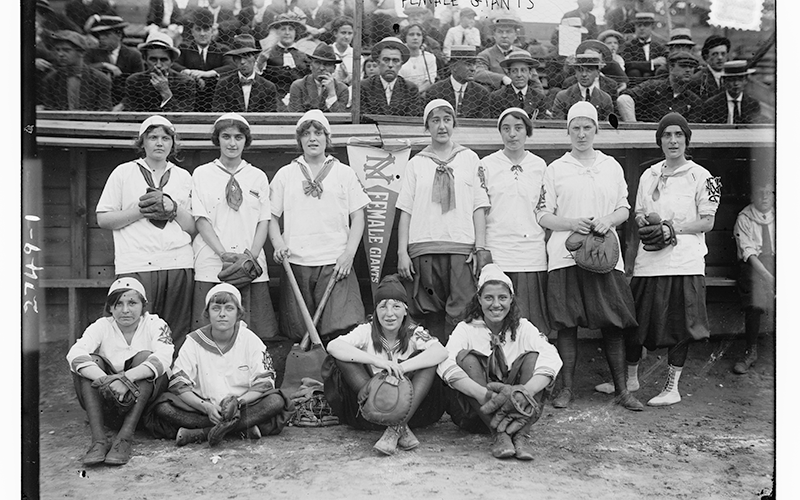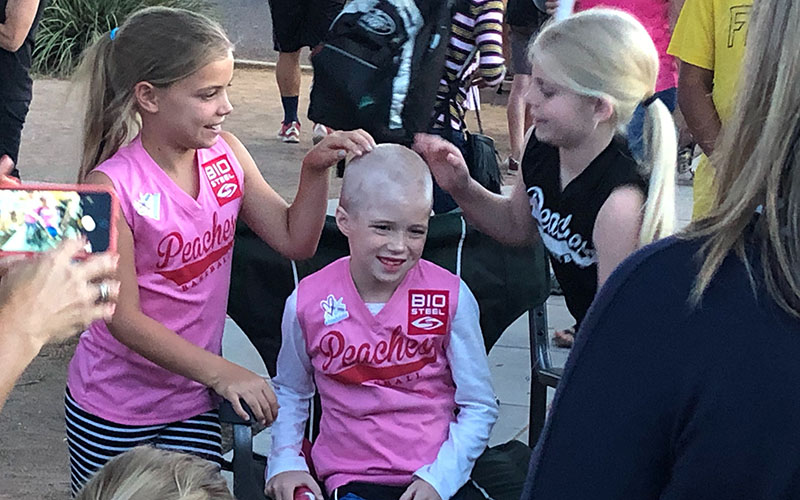
A team photo of the New York Female Giants in 1913. Early women’s teams – known as “bloomer girls” — often had a few men playing alongside them. (Photo courtesy of the Library of Congress)
SCOTTSDALE – Most people associate Rockford, Illinois, with the Rockford Peaches, the All-American Girls Professional Baseball League team depicted in Penny Marshall’s 1992 film “A League of Their Own.”
A few years from now, Rockford may be the home of women’s baseball.
Yes, you read that correctly. Women’s baseball. There’s a long history of girls and women in baseball that surprises many fans, even those well-versed in the game, said Kat Williams, the president of the International Women’s Baseball Center, who was in Scottsdale in October for the SABR Women in Baseball conference.
“They’re unaware that women have been part of baseball in every aspect of the sport since the inception of the game,” Williams said. “(Women’s baseball) did not start in 1943 with the AAGPBL (All-American Girls Professional Baseball League) and it did not end with them in 1954.”
The problem is that baseball historians don’t know much about the “bloomer girls” teams that barnstormed across America beginning in the late 1870s. Although records of men’s baseball from that time are detailed enough to note that Boston Red Caps pitcher Tommy Bond had 43 wins during the 1879 season, our knowledge of women ballplayers from that era is severely limited.
Thanks to the work of historians, we know a few names, such as Maud Nelson and Lizzie Murphy, but for the most part, the stories of these athletes have been lost. We can only imagine what amazing feats these women accomplished.
Our lack of information about women who played baseball in the 19th century spurs the question: How will stories of contemporary women survive? How can we preserve more recent stories of women in baseball?
“If we’ve learned anything from the past, it’s that you need to capture it now,” said Leslie Heaphy, a professor of history at Kent State. “Or else we’ll be coming back 100 years from now, trying to do the same exact thing, struggling to learn about” women ballplayers.
Heaphy said 19th century newspapers provide most of what we know about women baseball players from this time. They’re an imperfect source, considering the fact that the papers rarely identified women in pictures, and when they did they often omitted their surnames.
Heaphy discussed the topic during a break between presentations at the annual Arizona Fall League Experience co-hosted by the Society for American Baseball Research (SABR) and the International Women’s Baseball Center. SABR has hosted this local conference in metro Phoenix in conjunction with the Arizona Fall League for a number of years, but partnering with the center is a new development. Heaphy, who sits on the board of both organizations, had the idea of teaming the IWBC and SABR to host the annual conference this year.
“SABR wanted to do something with the IWBC, some kind of conference that would focus on women,” Heaphy said. “SABR has been focused on diversifying its membership, so it seemed like a win-win for everybody.”
The International Women’s Baseball Center formed in 2014 with a goal to preserve and protect the legacy of girls and women in baseball on a global scale. From the beginning, IWBC board members floated the idea of creating a home for women’s baseball, a central place to celebrate their contributions and preserve their stories. The opportunity to build such an institution fell into the center’s lap.
Shortly after the center was founded, Perry Barber, a longtime professional umpire and advocate for women in baseball, was working at a tournament at Beyer Stadium in Rockford. Greg Schwanke, who runs the donor group Friends of Beyer Stadium, approached Barber after the game. Schwanke asked Barber if she knew of a nonprofit connected to women’s baseball.
Schwanke has been involved with Beyer Stadium restoration efforts for nearly a decade, according to the Rockford Register Star. In Schwanke’s mind, donating the dilapidated property across from Beyer Stadium to a women’s baseball organization was the best way to keep the spirit of the Rockford Peaches alive.
Around midnight that evening, Barber called Williams and said, “Kat, You’re not going to believe this,” Williams recounted, detailing Schwanke’s desire to donate the property surrounding the field to the International Women’s Baseball Center.
Five years after Barber and Schwanke’s conversation, plans are in the works to construct a combination museum, education center and training facility where the Peaches once played. In July, the IWBC announced it had secured more than $125,000 to build this mecca of women’s baseball. The IWBC raised an additional $100,000 recently by hosting events to pay homage to film director Penny Marshall, who died in December 2018.
Architectural designs for the museum are complete and ready to go. The drawings were revealed to the public at the Penny Marshall celebration. The design is a blueprint for the first of nine outdoor pylons, which will form an expansive outdoor plaza.
“Our hope is that by seeing this unveiled, it will encourage people to get behind us and jump on board,” Williams said. “We raised enough money through (the Penny Marshall) event to pay for the first pylon memorial and the beginning of a second.”
There is still more fundraising to do. Assuming the project sticks to budget, building a home for women’s baseball will cost $7.4 million. To those involved, it’s a small price to pay compared with the cost of losing a generation’s worth of stories and tales of women in baseball.
Most baseball fans knew little about the All-American Girls Professional Baseball League before 1992, when “A League of Their Own” hit theaters. Although the home for women’s baseball won’t be completed for several years (in 2021, if all goes as planned), the International Women’s Baseball Center’s dream of creating a museum and education center is nearly a reality.
“There is no women’s hall of fame. There is no central archive,” Williams said. “There’s no home for women in baseball, and Rockford, Illinois, will be it.”

